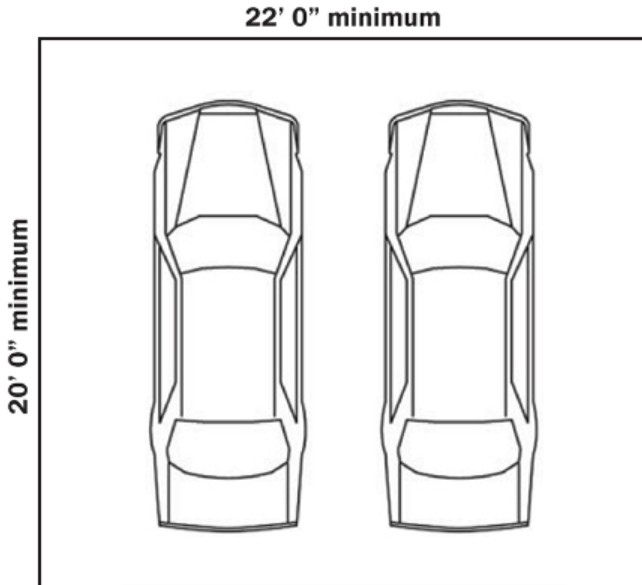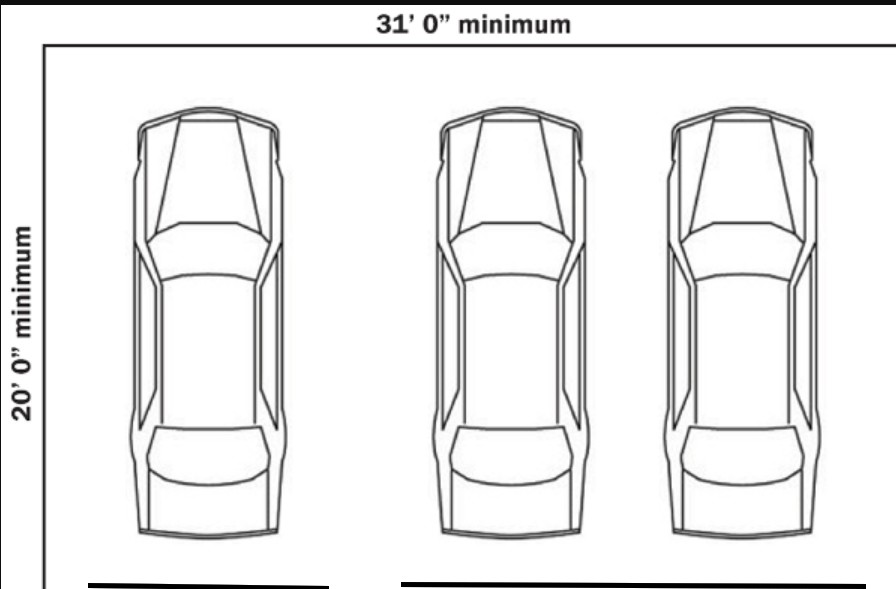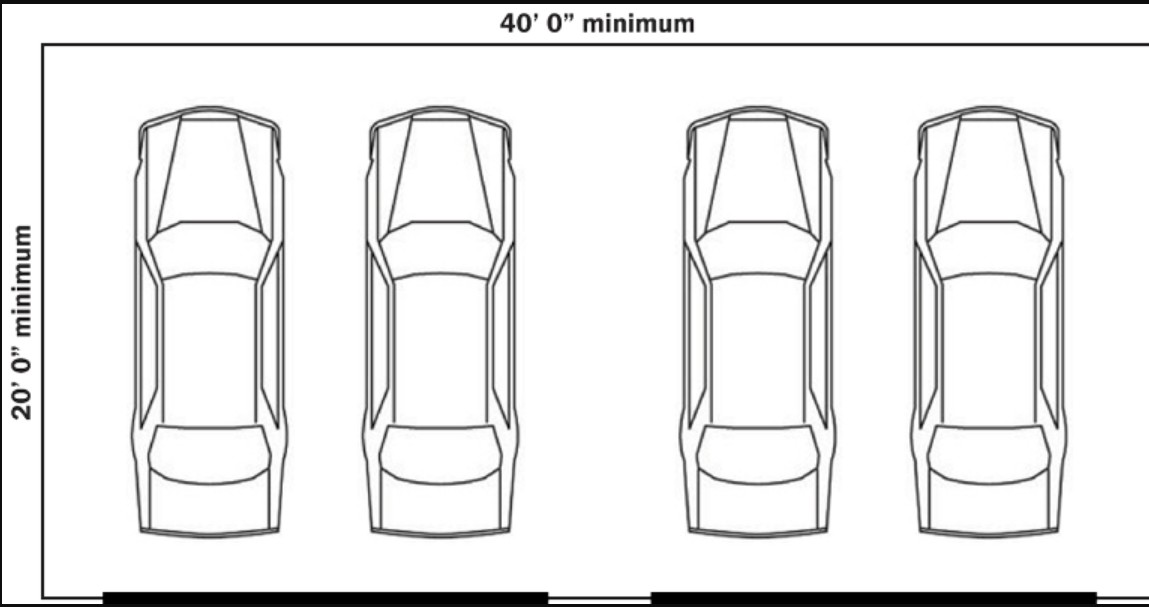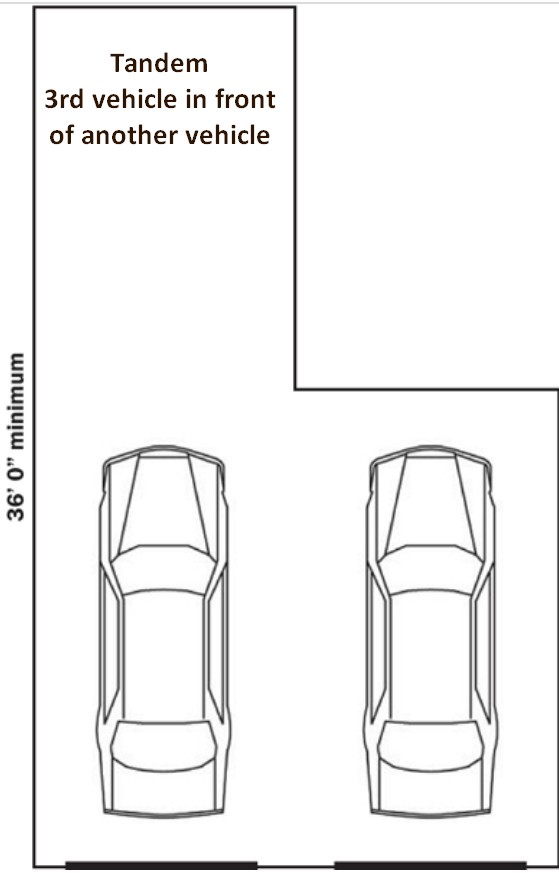Standard Garage Sizes
for 1, 2, 3, 4 Cars and Tandem parking.Garage Size
"I wish my garage was smaller."
Said – Nobody!Building a garage isn’t as easy as it first might seem. In fact, the single biggest mistake made is in underestimating the amount of space needed.






Height
It’s easy to miscalculate the height of a garage. This important dimension goes beyond the height of your car. You must account for door clearance, garage door openers, headroom, overhead lighting, and storage space.Remember, your vehicle’s antenna may be taller than the roof, so take that into account when choosing the door height.
Width
No matter if you’ll be using a parking aid or not, you’ll want some extra width. You should be able to open the doors on both sides while also having some clearance to get around them. This comes in handy when cleaning the car or if you do your own vehicle maintenance.Depending on the amount of equipment you plan to store (lawnmowers, tool cabinets, etc.), you may even want to go one vehicle size up (ie: get a 3-car garage even though you only have 2 cars).
Depth
The most notorious miscalculation is garage depth. At a minimum, you should be able to walk all the way around your car while it’s parked. The space in front of your vehicle is also the most common location for storage and workbenches.The depth of your garage may be the most important measurement to consider. Make absolutely sure you will have a garage that’s comfortably deep for your needs.
Plan Ahead
Your vehicle isn’t a permanent fixture. You may eventually trade in your full size truck for something smaller and more fuel efficient. Likewise, you may need to exchange that small 2-door for a minivan as your family grows.Finally, think about any older children in your home. If they’re approaching driving age, will they have their own dedicated vehicle? If so, make sure you have space for it when the time comes.
Important Note About Car Widths
Keep in mind that when you're trying to determine your optimal garage size, don't forget to add an additional 5 to 6 feet to the width of a vehicle to account for doors being open on both sides. Sports cars, longer cars, coupes, and heavy duty trucks will typically be wider than economy cars, shorter cars, sedans, and standard pickup trucks.Compact Cars
Examples: Kia Rio, Chevy Cruze, Mazda 3, Ford Focus, Toyota Corolla
Average Length: 14 feet and 8 inches
Average Width: 5 feet and 10 inches
Average Height: 4 feet and 9 inchesMid-Size Cars
Examples: Honda Accord, Audi A4, Mazda 6, Toyota Camry, BMW 3 Series
Average Length: 15 feet and 10 inches
Average Width: 6 feet and 1 inch
Average Height: 4 feet and 9 inchesFull-Size Cars
Examples: Toyota Avalon, Chrysler 300, Dodge Charger, Chevy Impala, Genesis G90
Average Length: 16 feet and 8 inches
Average Width: 6 feet and 2 inches
Average Height: 4 feet and 10 inchesMid-Size Trucks
Examples: Ford Ranger, GMC Canyon, Toyota Tacoma, Nissan Frontier, Chevy Colorado
Average Length: 17 feet and 9 inches
Average Width: 6 feet and 3 inches
Average Height: 5 feet and 10 inchesFull-Size Trucks
Examples: Chevy Silverado, Ford F-150, GMC Sierra 1500, Dodge Ram 1500, Toyota Tundra
Average Length: 19 feet and 6 inches
Average Width: 6 feet and 8 inches
Average Height: 6 feet and 4 inchesCrossover SUVs
Examples: Honda CR-V, Toyota RAV4, Hyundai Sante Fe, Mazda CX-5, Nissan Rogue
Average Length: 15 feet and 3 inches
Average Width: 6 feet
Average Height: 5 feet and 7 inchesMid-Size SUVs
Examples: Ford Explorer, Dodge Durango, Honda Pilot, Kia Sorento, Toyota 4Runner
Average Length: 16 feet and 4 inches
Average Width: 6 feet and 5 inches
Average Height: 5 feet and 11 inchesFull-Size SUVs
Examples: Toyota Sequoia, Cadillac Escalade, Ford Expedition, Chevy Suburban, GMC Yukon
Average Length: 17 feet and 4 inches
Average Width: 6 feet and 10 inches
Average Height: 6 feet and 4 inchesMinivans
Examples: Honda Odyssey, Toyota Sienna, Kia Sedona, Chrysler Pacifica
Average Length: 16 feet and 10 inches
Average Width: 6 feet and 7 inches
Average Height: 5 feet and 9 inches1-Car Garage Dimensions
Note: All measurements referenced in these garage size diagrams are referring to the interior dimensions. Add 6-7 inches per wall for exterior dimensions.1 car garage size
For a Car or Crossover SUV
Taking these measurements into account, the most common conservative garage size for a single car will be 20? long, 12? wide, and 7? tall. You can get away with a 8? by 7? garage door, but may prefer one that’s 8? tall for more headroom.Minimum dimensions for a 1-car garage:
12 ft. wide x 20 ft. deepCommon garage widths are 12?, 14?, or 16?; while the length most often measures 20?, 22?, or 24?.
Of course, even average garage sizes vary based on usage, and many homeowners prefer the superior headroom of an 8-foot door and higher interior clearance. Remember, the garage door is your ceiling when open, so choose your garage door height accordingly.
On the large size, a single car garage measuring 24? by 16? by 8? will provide space for one foot deep shelves on both sides and 10 to 12 feet of work and living space behind. Additionally, you have room to add one-foot tall suspended storage racks, making this an excellent size for a hybrid car/storage/living space.
For a Truck, SUV, or Minivan
Full-sized trucks and SUVs (and minivans) are much bigger than the average car and require a larger garage. Minivans and SUVs require additional rear-loading clearance so they essentially have the same height as a full-size truck when the rear is open.Due to their increased size, the minimum comfortable size for a single large vehicle would be 28? long, 16? wide (with 9? by 8? garage door), and 8? tall. You’ll want a wider garage door width to avoid losing your mirrors when not perfectly aligned during entry/exit.
2-Car Garage Dimensions
2 car garage size
Things become a little more complicated once you expand to multiple cars. This is primarily due to the choice of a wider 16? garage door or two 8?, 9?, or 10? doors. The average lengths tend to remain 20? to 24?, while the height should be calculated based on the tallest vehicle in your family fleet.Unlike single car garages, you only need clearance for the inside doors of one car at a time.
Minimum dimensions for a 2-car garage:
22 ft. wide x 20 ft. deepA fairly common form of multi-car garage, families often use one side for living or storage space when they only have one vehicle. These garages will usually use two 9? or 10? doors and may have some form of divider to separate the two spaces aesthetically. Single 16? doors are more common when two vehicles are being stored.
When calculating the width you’ll need, add the width of your vehicles plus 7? 6? minimum to account for door clearance. The average width for a two-car garage will usually be between 22? and 26?. A larger width not only leaves room for side storage, but also creates more leeway for crooked parking.
3-Car Garage Dimensions
3 car garage size
Three car garages require a minimum of 10? for car door clearance and may use one double-wide (16?) door and one regular door or three regular doors. In general, common widths for a 3-car garage are 31 to 34 ft. while the common depths are 20 to 24 ft.Minimum dimensions for a 3-car garage:
31 ft. wide x 20 ft. deep (unless tandem)4-Car Garage Dimensions
4 car garage size
A true rarity, four car garages can handle a small fleet of vehicles. These garages may have one or two double-width doors and up to four single doors. Of all the garage sizes, these monsters rely least on the average width of a car, since the occupying vehicles will most likely vary in size.Minimum dimensions for a 4-car garage:
40 ft. wide x 20 ft. deep (unless tandem) or 20wide x 40 long and doors on the sidewall.Many owners will either assign specific bays to specific vehicles, having wider doors for trucks than cars or have all bays big enough for their largest vehicle. Five car door lengths (or 12? 6?) should be added to the vehicle widths for a minimum space requirement. A good rule of thumb is to have a width of no less than 40?.
Tandem Garage Dimensions
Tandem garage size
This is a special version of a multi-car garage where the two cars are stored in line and not side-by-side. The width and height for tandem garages are the same as a regular garage, while the depth is usually 36 to 40 feet to allow for safer parking or for use as tool area or shop.Tandem garages may be one to three bays wide with one or more of those bays allowing for tandem parking.
Carports
Carports are another matter entirely. These open-plan parking spaces make it easy, as you only need minimum dimensions and don’t have to worry about storage or living space. Base the size of your carport on your vehicle’s clearance requirements using these simple questions.How Long is a Car in Feet?
Cars (and trucks) range in average length from about 13 to 20 feet. See the Average Vehicle Dimensions section above to get a good idea of the length of your vehicle or simply measure it.Give yourself a bit of leeway, especially if you don’t plan on adding some form of stop to the rear of the port. As a general rule, carports tend to be between 21? and 26? in length.
How Wide is a Car in Feet?
Vehicle widths range from about 6 to 7 feet with the doors closed. See the Average Vehicle Dimensions section above to get a good idea of the width of your vehicle or simply measure it. You will want to factor another 5 feet to have both doors open and give a little extra leeway off-center parking.As carports tend to be open space, the width for an average car is about 12 feet. You may wish to go up to 16 feet for wider vehicles.
How High Should the Roof be in Feet?
Picking the height for your carport is a lot more lenient than a garage, as there are no doors. Instead, the average carport is about 12 feet tall to allow plenty of clearance and the option of lighting. Some extra large vehicles, such as RVs will need a higher roof.Single vs Double Carports
As mentioned above, single carport dimensions are fairly basic, but what about double carport dimensions? While the length and height remain the same, the width for a two-car carport will range between 18 to 24 feet on average.Take into account the widest vehicle you plan to store and base your width off of double that width plus door clearance for the best fit.